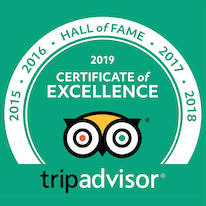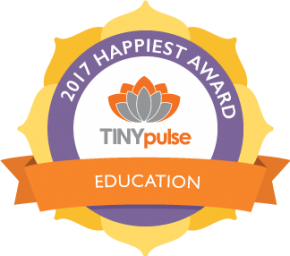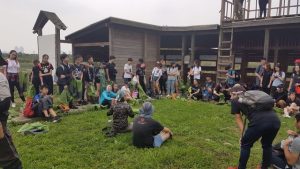
“Service: An unpaid and voluntary exchange that has a learning benefit for the student and a collaborative and reciprocal engagement with the community in response to an authentic need. The rights, dignity, and autonomy of all those involved are respected”-IB Organisation
As The Hutong has continued to expand outside of mainland China to destinations that include Hong Kong to branch out and work with different partner organizations to create exceptional learning-service activities. It may seem odd that we write learning-service instead of service-learning. Let us explain: service-learning is an educational approach that integrates learning objectives and community service. However, without the understanding of the local culture and their specific needs and providing unprepared efforts, it may end up being more harmful than helpful to the community and not a learning experience for the volunteers, therefore we must learn first how to serve, thus we call it learning-service. On a recent trip with The International School of Macao (TIS), learning-service was one of the crucial components of their 5 day trip to Taiwan.
“All of the Secondary School Experience Week programs at The International School of Macao (TIS) are framed by creativity, activity, service (CAS). In this way, we are able to orient our experiential and service learning toward educational outcomes, provide students with something more than ordinary tourism, and, foster a better understanding of how to respond to the needs of others. In 2019, most of TIS’ Experience Week service learning focussed on ecology and climate change including for example marine conservation, mangrove protection, and the removal of invasive species or waste materials from the natural environment.” Dennis L. Stuebing, Ph.D. CAS, Experience Week, and Service Coordinator
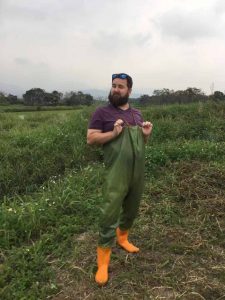
All of our programs have an educational focus such as local culture, history, environmental studies, language, physical challenge as our objective is to take into account the learning outcomes the schools want to achieve by the end of the program. Since schools often come to us with a request to fulfill their service requirements during our experiential education programs, seeing the chance to get the students out of the classroom as an opportunity to engage them with service, we have been dedicating time to re-state, re-invent, and re-focus our programs to incorporate more meaningful learning-service. From our own perspective one of the major challenges with incorporating learning-service into our programs is how to make a meaningful and sustainable impact in the local communities during a trip that normally only lasts from three to five days.
In order to successfully incorporate service into our multi-day programs, we believe that we must learn first to more effectively and responsibly make positive impacts. In learning-service too often the “needs” being addressed may be more related to the volunteers’ schedules and ideas about the kind of service that feels good to offer, rather than what would benefit the community. One of the ways that we ensure that we “learn first” is through careful research and multiple visits to the communities, as well partnering with organizations that assist us to make certain that the learning and the service that we take part in address the communities’ authentic needs.
We developed a meaningful half-day of learning-service activities and engagement for the students from TIS. Students took a full morning to learn about the importance of the wetlands just within reach of Taipei’s urban sprawl, the Guandu Nature Park. After initial site visits to the Park, earlier in the Fall of 2018, The Hutong was able to set up a working partnership with the Park in order to help benefit the wildlife that thrives there, and to positively contribute to the work that the employees and the volunteers are doing to make the Park a better place for the otherwise vulnerable ecosystems and habitat.
Located in between Taipei City and Tamsui, Guandu Nature Park had become subject to heavily competing demands upon the land in a battle for economic growth vs. environmental protection. To give a specific example, in the mid 90s, these wetlands were on the verge of being drained in order to construct a large stadium. The Wild Bird Society of Taipei (WBST) began to protest and lobby to protect this area. After years of intense negotiation and cooperating with the local government, the area was eventually set aside for the creation of the Park. In 2001, the Park was assigned to be managed by the Wild Bird Society to protect a stable ecosystem with over 830 animal species, 230 bird species and a rich abundance of plants and organisms. Currently all ticket sales and funds for the Park go 100% towards supporting its management and upkeep. The efforts of The Wild Bird Society of Taipei focus on the following goals:
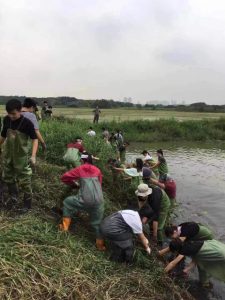 • Environmental protection, research and long-term monitoring
• Environmental protection, research and long-term monitoring
• Public education
• Recreation and appreciation of natural resources
• Linking culture and environment
After arriving at the park with the TIS students, we first made our way to the Nature Center and the bird observatory, where our host, Lisa Pin-Hsiu Chou 周品秀 helped to introduce and point out an endangered bird species through one of the binoculars angled towards the wetlands. Lisa was very familiar and felt passionate about her area of expertise. A native of Taiwan, she grew up and spent much of her youth in Canada, but decided to return to her home and get involved with environmental conservation. We were fortunate enough to have Lisa along with three other staff members: Lin Jiahe 林家荷, Chang-shin Lin 林章信 and Lei Chu 朱磊 with us throughout the morning. After watching a bilingual introduction video which outlined the parameters, different species, and major benefits of the Park, Lisa introduced us to our task. Each participant was given a pair of waders, work gloves, and a tool to cut out the Para Grass, an invasive grass species in one of the freshwater pools within the Park. Students worked in teams to remove the Para Grass. Removing it would allow the growth of lily pads that a species of bird, the Pheasant-tailed Jacana uses during their breeding season. The Pheasant-tailed Jacana is native to Taiwan and has had a successful breeding record in the Park. The Park endeavours to create the type of habitat favoured by the Pheasant-tailed Jacana, namely a pond filled with floating-leaved aquatic vegetation, such as lilies, where they can walk on and even build their nest on.
Needless to say, the work was challenging, fun and messy, but gave students a chance to see things they had never seen before. During the removal of invasive grass from the water to the banks of the pond, Lisa suddenly held up a pair of toads that had been caught in the middle of mating. After calling attention to the passionate toad couple, Lisa set them back into the pond. Students toiled away on the banks, taking breaks to give names to the animals they spotted. We would only be clearing away the invasive grass from one side of the pond so as to make way for the amphibians, worms, and other “little lives” to migrate to the other side of the pond as they escaped our hustle and bustle of fervent activity.
After our half-day’s work, we sat down with Lisa outside and she broke down just how comprehensively complicated nature conservation could be. The toads were supposed to be there, the Para Grass that we had cut away was not. There was a species of snail and fish that we also didn’t want in the pond because, like the Para Grass, they were invasive species. She told about how some of the fields in the Park were converted back to rice paddies, and spoke about the water buffaloes. She explained details that are part of Nature’s intricate and challenging balancing act that the volunteers and staff at the Park have been studying for years. Although our class of students was only there for half a day, Lisa made it clear that our efforts made an impact.
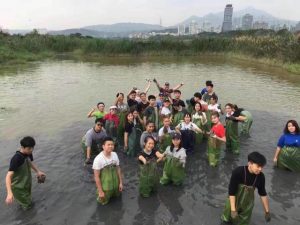
“We only have four staff here. The work that you guys did in 2 hours would take us three days to complete. We have really enjoyed working with you. It was great to see the interaction you had with your students and how you would relay some of my instructions and ask questions for clarification. We really liked the last part where you had the students in a circle and reassured them that it was okay to feel a little uncomfortable or nervous since this was new. I sometimes forget how strange and alien it is the first time you put on a wader and step into the water and have to move around. Thank you for reminding me.”
At the end of the half-day’s hard work, students remarked how much they enjoyed this service activity. One student even made the comment that he could “cut weeds everyday,” illustrating that the activity was not only meaningful, but also fun enough to be touted as a good way to spend a morning.
“Our students donned hip waders and rubber boots and got down and dirty while removing an invasive grass species from the wetlands. The students loved the opportunity to get hands-on with eradicating the grass to help protect the native species in the area. Our students demonstrated great teamwork and dedication as they worked together to remove giant swathes of unwelcome grass from the pond. Once finished, the overwhelming majority of the students expressed an incredible sense of accomplishment and felt that they had given back to the city that had welcomed them so warmly for the duration of their program.” Ian Jefferson, Grade 9 Humanities Teacher, High School World Geography Teacher and Trip Leader


